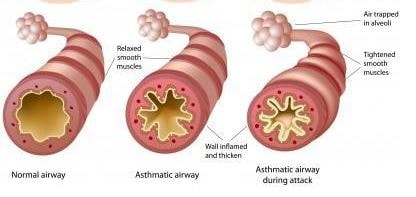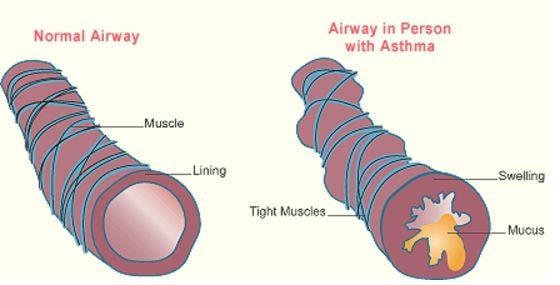What are Bronchial Spasms?
Bronchial Spasms also referred to as bronchospasms, are the unexpected and unusual constriction in the walls of the bronchioles which make it harder for the person to breathe.

Doing simple activities daily can be greatly affected when a person suffers from bronchospasms and most people who suffer this type of problem are those who also suffer from asthma. Bronchial spasms are divided into two kinds; paradoxical and acute spasms.
Acute spasms happen after an unanticipated constriction and it causes the respiratory airways to narrow down. This kind of spasm may be threatening since it can result to the production of mucus, which might cause more damage and additional blockage in the airways making it much harder to breathe. The airways may get inflamed as well.
Paradoxical spasms take place when certain medications are used to treat bronchial spasms and turns out to have harmful side effects; instead of managing allergic reactions, it makes the condition more aggravated.
What are the Symptoms?
The symptoms that might be experienced due to bronchial spasms might depend from one person to another in cases of the severity and time span.
As the muscles constrict, common symptoms occur and these include; wheezing, coughing, difficulty in breathing, shortness of breath and tightening or heaviness of the chest. The increased ventilation of the respiratory system extremely magnifies the effects of bronchial spasms.

What Causes Bronchial Spasms?
There are a number of factors that can possibly trigger bronchial spasms to occur. Triggers that usually happen include allergens such as pet hair, dust, molds or food like shellfish and nuts.
This condition may also be caused by irritants like smoke from cigarettes or in other areas that consist of smoke, chemicals, and aerosol sprays can also be another reason of developing bronchial spasms. Bronchial spasms is also said to be inherited from the family.
Other causes include:
- Pollens
- Emotional trauma that leads to anxiety or stress sometimes resulting to a constriction of the airways
- Respiratory infections due to flu and colds
- During exercise
- Unexpected changes in the weather
How is Bronchial Spasms Treated?
There are many ways to prevent or treat bronchial spasms whether it be natural methods or through medications, but it is still best recommended to consult a health practitioner before starting any treatment. Natural and herbal methods are very helpful and beneficial for a person’s health too.
These natural remedies include:
- Breathing Pattern – In the year 1960, a theory was formed by Dr. Buteyko from Ukraine that individuals who have asthma have the tendency to breath rapidly and they must try to control and lessen the breathing to minimize the symptoms including bronchial spasms. This type of therapy can help a person preserve high levels of nitric oxide and carbon dioxide. It also helps enhance lung functions.
- Black Cohosh Extract – Back in 1991, a Japanese theorized that black cohosh extract acting as spasmolytic agent that also consist of sedative properties can relax the muscles and nerves. For easier use of this extract, the herbs may be taken in tincture form.
- Thyme herb – According to a study in 2009, thyme herbs contain a large amount of flavonoids. The effect of these herbs is apparent on the tracheal muscle.
- Omega 3 – Another study had been performed and it proved that fish oil lowers the chances of developing bronchial spasms in athletes.
- Stop Smoking – It should be stopped to avoid other effects of bronchial spasms.
- Maintains An Ideal Weight – It is said that obesity can cause bronchial spasms and the study from other individuals proved that having an ideal weight means a lesser risk of developing the condition.
- Cut out salt and meat intake
- Avoid foods that causes allergic reactions
- Eat a Healthy Diet – This includes fruits and vegetables to reduce the risk of bronchial spasms. Many studies in 2004 showed that eating more vegetables and fruits decreases the risk for asthma and other than that, it promotes better living.
Aside from the natural remedies, an inhaler can be used as treatment for bronchial spasms in order to open the airways. Depending on the physician, the person may also be advised with cough suppressants or an expectorant to clear mucus secretions. The physician might also prescribe antibiotics in the presence of a respiratory infection.
References:
Bronchial Spasms–Causes and Cures at http://www.zoomhealth.net/BronchialSpasms-CausesandCures.html
http://www.wisegeek.org/what-is-a-bronchial-spasm.htm
Abramson MJ, Perret JL, Dharmage SC, et al. (2014 Sep 9). Distinguishing adult-onset asthma from COPD: a review and a new approach. Int J Chron Obstruct Pulmon Dis. 9:945-962.
Haggerty, Catherine L.; Ness, Roberta B.; Kelsey, Sheryl; Waterer, Grant W. (2003). “The impact of estrogen and progesterone on asthma”. Annals of Allergy, Asthma & Immunology 90 (3): 284.
Marsh, Alex; Gordon, David; Heslop, Pauline; Pantazis, Christina (2000). “Housing Deprivation and Health: A Longitudinal Analysis”. Housing Studies 15 (3): 411.
